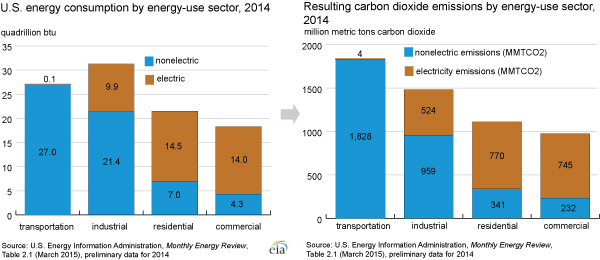
Note: Values expressed as carbon dioxide equivalents (CO2e) are calculated based on their 100-year global warming potential (GWP).
Did you know?
Fossil fuels supply 82% of the primary energy consumed in the United States and are responsible for 94% of total carbon dioxide emissions.
In the United States, greenhouse gas (GHG) emissions come primarily from the burning of fossil fuels in energy use. Energy use is largely driven by economic growth (with short-term fluctuations in growth rate) and by weather patterns that affect heating and cooling needs.
Carbon dioxide
Emissions of carbon dioxide (CO2) resulting from the combustion of coal, petroleum, and natural gas account for nearly 80% of total U.S. human-caused (anthropogenic) GHG emissions. There are many sources of nonenergy CO2 emissions, but those emissions account for a relatively small share of total GHG emissions.
Other greenhouse gases
There are several other greenhouse gases emitted by the United States as a result of human activity that are included in U.S. and international emissions estimates:
- Methane (CH4), which comes from landfills, coal mines, agriculture, and oil and natural gas operations
- Nitrous oxide (N2O), which comes from the use of nitrogen fertilizers, from burning fossil fuels, and from certain industrial and waste management processes
- High global warming potential (GWP) gases, which are human-made industrial gases
- Hydrofluorocarbons (HFCs)
- Perfluorocarbons (PFCs)
- Sulfur hexafluoride (SF6)
- Nitrogen trifluoride (NF3)
The energy connection
Fossil fuels consist of hydrogen and carbon. When fossil fuels are burned, the carbon combines with oxygen to create CO2. The amount of CO2 produced depends on the carbon content of the fuel. For example, for the same amount of energy produced, natural gas produces about half and petroleum produces about three-fourths of the amount of CO2 produced by coal.

Most carbon dioxide emissions come from petroleum and coal use
In 2014, 42% of U.S. energy-related carbon dioxide emissions came from the use of petroleum fuels, 32% came from coal, and about 27% came from natural gas. Although the industrial sector is the largest consumer of energy (including direct fuel use and purchased electricity), the transportation sector emits more CO2 because of its near complete dependence on petroleum fuels.
The residential sector and the commercial sector have lower emission levels than the transportation sector and the industrial sector. Most of the CO2 emissions for the residential sector and the commercial sector are from fossil fuel combustion to produce electricity.

Coal is the dominant emissions source related to electricity generation
Electricity generation accounted for about 39% of U.S. primary energy consumption in 2014 and was responsible for 38% of energy-related carbon dioxide emissions. Coal accounted for 76% of CO2 emissions resulting from the generation of electric power, and natural gas accounted for 22%.




